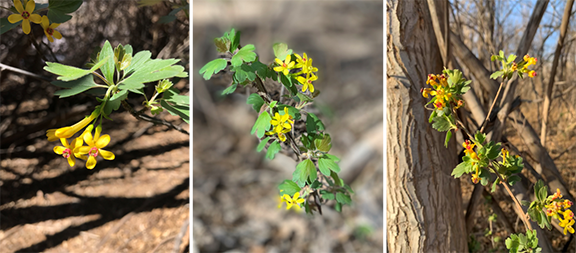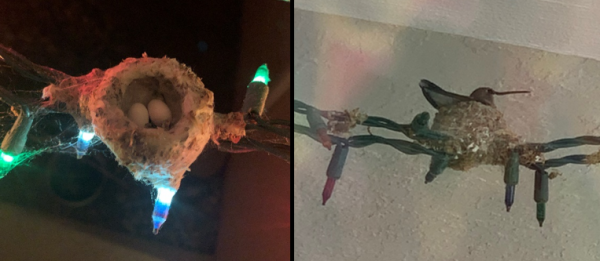April 17, 2021
Hummingbirds Are Back

This week, in honor of the golden currant (Ribes aureum) shrubs blooming in the Los Lunas bosque and at the City of Albuquerque BioPark Botanical Garden, I’m writing about hummingbirds in the garden. I learned from a local birder (I wish I could remember who it was!) that you know it’s time to put out your hummingbird feeders when the golden currants are in bloom.
If you’re curious about creating a hummingbird haven in your yard, the book Hummingbird Plants of the Southwest by local author Marcy Scott is a great place to start. On top of excellent details on 120 hummingbird plants for gardens in our region, Scott profiles the 14 hummingbird species found in the Southwest. She provides precise information on how to create prime hummingbird habitats. “For beginners especially, penstemons are great starter plants for the hummingbird garden and, given a mostly sunny spot and good drainage, they are easily grown most anywhere in the Southwest.” The trick is selecting a mix of flowering plants so that your garden offers nectar throughout the growing season. Scott includes 21 different penstemon species in her book along with their blooming periods. And while red flowers are famously attractive to hummingbirds, “The quintessential hummingbird flower, in summary, will usually be red, reddish-pink, orange, or yellow (and yes, there exist a number of blue, purple, and even white exceptions to this rule).”
Last summer, I counted as many as six hummingbirds at once, buzzing between three feeders in my backyard. Even if you’ve only seen one hummingbird at a time, I’ve got great news for you. As David Allen Sibley writes in his new book, What It’s Like to Be a Bird, “A rough rule of thumb for estimating the total number of hummingbirds using your feeder is to count the most birds you see at one time and multiply by ten.” Having multiple flowering plants and feeders around your yard can also help avoid having one dominant bird who chases others away. Sibley adds, “A typical individual visits the feeder about once every thirty minutes, and in between it will be catching insects (which can constitute up to 60 percent of its diet) and visiting flowers.”

For hummingbird feeders, I found the following recommendations in a 1999 Southwest Yard & Garden column by my predecessor Dr. Curtis Smith that includes tips from Dr. Jon Boren, then NMSU Extension Wildlife Specialist and current Associate Dean and Director of New Mexico’s Cooperative Extension Service:
- To make your own artificial nectar solution, mix 1 cup of plain white sugar (not honey) in 4 cups of water.
- Red food coloring is unnecessary and may be unhealthy for the birds.
- Red decor on the feeder helps grab hummingbirds’ attention.
- Clean feeders thoroughly with a solution of 1 tablespoon of white vinegar added to 1 cup of water every 2–3 days when the weather is warm.
Dr. Boren also suggested getting feeders with a perch to encourage the birds to feed for longer periods of time. An added bonus of the perch is that these busybodies are way easier to photograph when they’re sitting.
Looking for a great gift for Mother’s Day or Father’s Day this year? How about a hummingbird habitat starter kit that includes a few native flowering plants, a feeder, and a birding book? I hope my parents don’t read this column!
Marisa Y. Thompson, PhD, is the Extension Horticulture Specialist, in the Department of Extension Plant Sciences at the New Mexico State University Los Lunas Agricultural Science Center, email: desertblooms@nmsu.edu, office: 505-865-7340, ext. 113.
Links:
For more gardening information, visit the NMSU Extension Horticulture page at Desert Blooms and the NMSU Horticulture Publications page.
Send gardening questions to Southwest Yard and Garden - Attn: Dr. Marisa Thompson at desertblooms@nmsu.edu, or at the Desert Blooms Facebook page.
Please copy your County Extension Agent and indicate your county of residence when you submit your question!